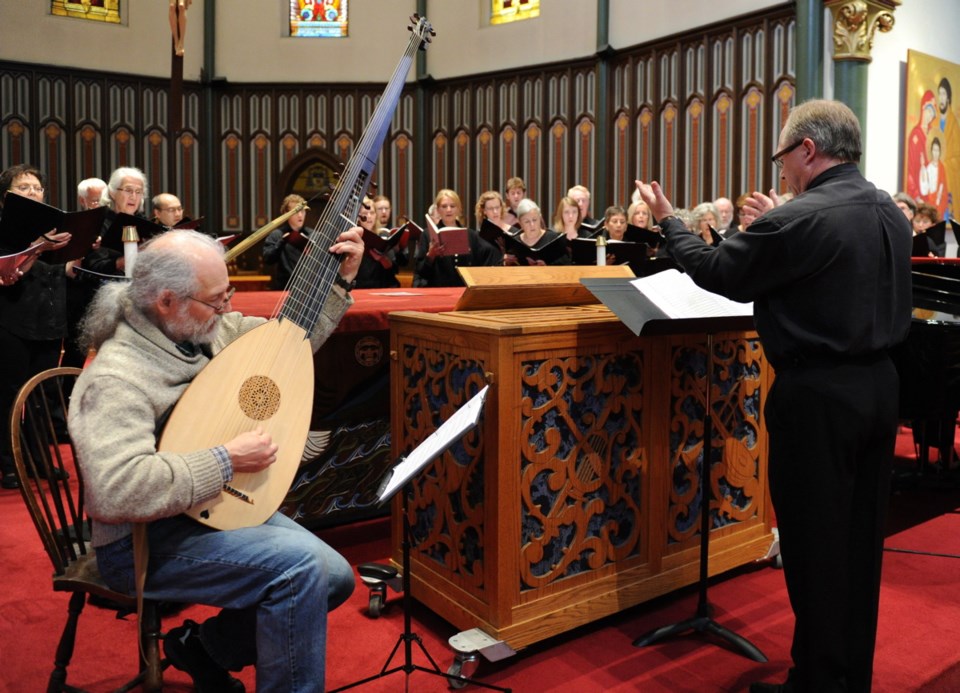IN CONCERT
La Rose des Vents: Around the Compass Rose: Wind Music from Far and Near
When/where: Tonight, 8 p.m., St. Matthias Anglican Church (600 Richmond Ave., at Richardson Street)
Tickets: $15, $10 with ticket/voucher for Monteverdi Vespers
Victoria Philharmonic Choir: Monteverdi Vespers of 1610, conducted by Peter Butterfield
When/where: Saturday, 8 p.m., St. Andrew's Cathedral (740 View St., at Blanshard St.); pre-concert talk at 7:15
Tickets: $30, students $15. Online at vpchoir.ca; in person at Ivy’s Bookshop, Munro’s Books, Tanner’s Books, The Shieling Cards & Gifts, La Tavola Kitchenware Boutique and Long & McQuade
The Victoria Philharmonic Choir will close its season in splendid fashion on Saturday when it performs Monteverdi’s grand and glorious Vespers. Published in 1610, the Vespers is a pinnacle of early-Baroque music, yet apparently only excerpts from it have ever been performed here; I queried some local musicians whose experience of Victoria dates back as far as the 1960s, and none could recall hearing the complete work. So kudos to the VPC for this important, overdue première, a treat for choir and early-music fans alike.
The 400-year wait is perhaps forgivable: The most ambitious choral work written before Bach’s time, Monteverdi’s Vespers is long, complex and technically treacherous, and makes unconventional, very particular demands in terms of performance practice and instrumentation. The VPC’s music director, Peter Butterfield, who has conducted it in Vancouver, says presenting it here has been “a tremendous challenge,” musically and logistically.
Vespers is part of the Divine Office, the daily cycle of prayer services in the Roman Catholic Church. The services are associated with different times of day, with vespers traditionally taking place at twilight. Monteverdi’s setting was intended for the special vespers services held on feast days of the Virgin Mary — hence the Italian title Vespro della Beata Vergine.
The work includes psalm, hymn and Magnificat settings, non-liturgical motets, even a “sonata” that is essentially an instrumental piece over which a soprano line of plainchant is superimposed. There are pieces long and short, ornate and plain, exuberant and intimate, scored for many kinds and combinations of choral, solo-vocal and instrumental forces, and featuring myriad structural, stylistic and rhetorical devices both venerable and novel.
As published, the Vespers seems as much a compendium as an integral work; Monteverdi may have conceived it a kind of portfolio in which he could display his mastery of the various techniques then available to a composer of sacred music. In any event, he considered it important enough that he dedicated the published edition to the pope.
The VPC will perform the complete work in its published order — 13 movements, running about 90 minutes. (Monteverdi actually published 14 movements, but the last two are alternatives for the closing Magnificat; the VPC will perform the larger of these two, with all of the performers participating.)
The 60-voice choir will be divided into six to 10 parts and supplemented by seven soloists — two each of sopranos, tenors and basses, plus a countertenor.
The 17-piece orchestra, led by violinist Christi Meyers, will include a string sextet, two recorders, two cornetts, three trombones, and continuo (archlute, theorbo, Baroque guitar, organ). Particularly noteworthy here is the horn-shaped cornett, which is a unique hybrid: a woodwind instrument played with a brass-type mouthpiece. Prized for its beauty, agility, and expressivity — its tone suggests an exquisitely refined trumpet-the cornett was one of the quintessential sounds of early-Baroque music.
Monteverdi’s score is frequently not specific about who should sing and play what, leaving Butterfield to make “many, many, many decisions” regarding performing forces. Among those decisions was how to exploit the resonant acoustic and the interior spaces (including balconies) of St. Andrew’s Cathedral, to create the echoes and other sonic effects sometimes demanded by the music. Indeed, Butterfield says he would not have programmed the Vespers without St. Andrew’s at his disposal.
The five cornett and trombone parts, incidentally, will be performed by La Rose des Vents, a Montreal-based ensemble formed in 2009 and devoted to historical wind instruments. (Their name means “the compass rose.”) This ensemble will also offer its own concert tonight, a program of 16th- and 17th-century wind music from England, Spain, Germany, Austria, Flanders, Italy and Mexico, including a canzona in the early-Baroque Italian style composed by one of its co-founders, trombonist Catherine Motuz.



